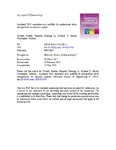Anodised TiO2 nanotubes as a scaffold for antibacterial silver nanoparticles on titanium implants
| dc.contributor.author | Gunputh, UF | |
| dc.contributor.author | Le, H | |
| dc.contributor.author | Handy, RD | |
| dc.contributor.author | Tredwin, C | |
| dc.date.accessioned | 2018-06-20T14:37:05Z | |
| dc.date.available | 2018-06-20T14:37:05Z | |
| dc.date.issued | 2018-10-01 | |
| dc.identifier.issn | 0928-4931 | |
| dc.identifier.issn | 1873-0191 | |
| dc.identifier.other | 0 | |
| dc.identifier.uri | http://hdl.handle.net/10026.1/11685 | |
| dc.description | publisher: Elsevier articletitle: Anodised TiO2 nanotubes as a scaffold for antibacterial silver nanoparticles on titanium implants journaltitle: Materials Science and Engineering: C articlelink: https://doi.org/10.1016/j.msec.2018.05.074 content_type: article copyright: © 2018 Elsevier B.V. All rights reserved. | |
| dc.description.abstract |
Medical grade titanium alloy is widely used for bone/dental implants, but the material alone has no innate antimicrobial properties that would reduce infection risk following surgery. However, silver nanoparticles (Ag NPs) are known to be antibacterial. This study investigated the growth of Ag NPs on titanium dioxide nanotubes (TiO2 NTs) on Ti-6Al-4V discs. The TiO2 NTs were grown on the Ti alloy using an electrochemical method, and then decorated with Ag NPs. The Ag NPs were synthesised by chemical reduction using δ-gluconolactone. A silver ammonia solution (silver nitrate + liquid ammonia) was used as the source of silver. Two separate approaches were used: (1) The δ-gluconolactone was mixed with the silver ammonia and then exposed to the TiO2 NTs (the 'mixing method'), which produced micron-sized clusters of the Ag NPs. (2) The TiO2 NTs were exposed to the silver ammonia first and then to δ-gluconolactone (the 'sequential addition method'), which resulted in the formation of nano-sized clusters of the nanoparticles. The Ag-TiO2 composites were confirmed by scanning electron microscopy and the elements analysed using energy dispersive X-ray spectroscopy (EDS). The composite coatings were exposed to a simulated body fluid for 24 h in order to determine the total Ag released. The release from the micron-sized clusters from the mixing method (14.6 ± 0.67 ppm) was higher than that from the nano-sized clusters (4.05 ± 0.36 ppm) when 0.015 M of silver ammonia was used. Additionally, Staphylococcus aureus, was cultured on the composite coatings for 24 h. Both the micron- and nano-sized clusters of the Ag NPs were found to be antibacterial using the Live/Dead assay. Overall, δ-gluconolactone was successfully used to reduce silver to Ag NPs on the surface of TiO2 NTs. The sequential addition method was the preferred method of synthesis because of its slower silver release, better coverage of the Ag-NPs on the TiO2 NTs and strong antibacterial properties. | |
| dc.format.extent | 638-644 | |
| dc.format.medium | Print-Electronic | |
| dc.language | en | |
| dc.language.iso | en | |
| dc.publisher | Elsevier BV | |
| dc.subject | Titanium alloy | |
| dc.subject | Silver nanoparticles | |
| dc.subject | TiO2 nanotubes | |
| dc.subject | Anodisation | |
| dc.subject | Antimicrobial coating | |
| dc.title | Anodised TiO2 nanotubes as a scaffold for antibacterial silver nanoparticles on titanium implants | |
| dc.type | journal-article | |
| dc.type | Article | |
| plymouth.author-url | https://www.ncbi.nlm.nih.gov/pubmed/30033297 | |
| plymouth.volume | 91 | |
| plymouth.publication-status | Published | |
| plymouth.journal | Materials Science and Engineering: C | |
| dc.identifier.doi | 10.1016/j.msec.2018.05.074 | |
| plymouth.organisational-group | /Plymouth | |
| plymouth.organisational-group | /Plymouth/Faculty of Health | |
| plymouth.organisational-group | /Plymouth/Faculty of Health/Peninsula Dental School | |
| plymouth.organisational-group | /Plymouth/Faculty of Science and Engineering | |
| plymouth.organisational-group | /Plymouth/Faculty of Science and Engineering/School of Biological and Marine Sciences | |
| plymouth.organisational-group | /Plymouth/REF 2021 Researchers by UoA | |
| plymouth.organisational-group | /Plymouth/REF 2021 Researchers by UoA/UoA03 Allied Health Professions, Dentistry, Nursing and Pharmacy | |
| plymouth.organisational-group | /Plymouth/REF 2021 Researchers by UoA/UoA06 Agriculture, Veterinary and Food Science | |
| plymouth.organisational-group | /Plymouth/Research Groups | |
| plymouth.organisational-group | /Plymouth/Research Groups/Marine Institute | |
| plymouth.organisational-group | /Plymouth/Users by role | |
| plymouth.organisational-group | /Plymouth/Users by role/Academics | |
| dc.publisher.place | Netherlands | |
| dcterms.dateAccepted | 2018-05-26 | |
| dc.rights.embargodate | 2019-5-28 | |
| dc.identifier.eissn | 1873-0191 | |
| dc.rights.embargoperiod | Not known | |
| rioxxterms.versionofrecord | 10.1016/j.msec.2018.05.074 | |
| rioxxterms.licenseref.uri | http://www.rioxx.net/licenses/all-rights-reserved | |
| rioxxterms.licenseref.startdate | 2018-10-01 | |
| rioxxterms.type | Journal Article/Review |


